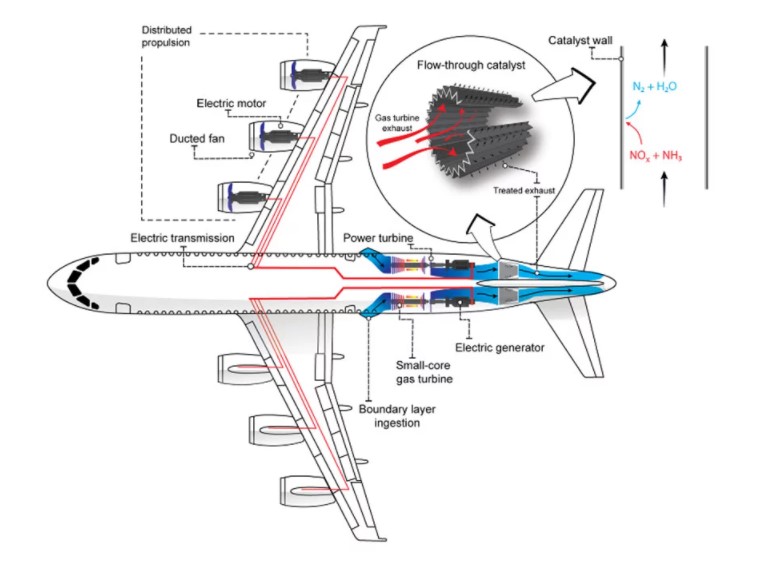
A few weeks ago we wrote about the Flying-V hydrogen jetliner concept that showed great promise for greener aviation. Well, if you thought that was impressive, wait until you see this new hybrid-electric plane concept. It can reportedly capture 95% of the plane’s harmful nitrogen oxide emissions using an emissions control system adaptation.
Aircraft engines produce harmful pollutants such as nitrogen oxide and carbon dioxide emissions, which contribute around 2-3% of the global total. Sound familiar? It should as this is the same poisonous gas that diesel vehicles generate and the issue surrounding the infamous Volkswagen emissions scandal.
So who came up with this new hybrid-electric plane concept and how does it work? Could planes of the future use a similar emissions control system than diesel ground vehicles?
Developing The Hybrid-Electric Plane Concept
One good thing that came from the VW emissions scandal is this new hybrid-electric plane concept. MIT engineers responsible for the design took inspiration from the debacle studying its health impacts on the population.
They wanted to see if they could apply similar emissions control systems from diesel trucks and other ground vehicles into the propulsion systems for aircraft. However ingenious and ambitious, this idea does pose several challenges.
The main issue is the gas turbines underneath the wings. Not only do they make the plane propellers spin but they also pump exhaust out the back of the aircraft. If they attached an emission control device here, it would severely hamper the aeroplane’s thrust but they’ve come up with a brilliant solution.
Designing The Future Hybrid-Electric Plane
The engineers believe that their solution can work by repositioning the gas turbines inside the plane’s cargo hold. By changing the design based on their hybrid-electric concept, the cargo hold will capture as much as 95% of the plane’s harmful nitrogen oxide emissions.
The idea is that the gas turbines will power a generator instead of directly driving the propellers. This means it will produce electricity that can be used to power the propellers instead. From there, an emission control system located in the cargo hold can capture exhaust fumes pouring from the gas turbines cleaning the air before releasing it into the atmosphere.
Researchers say that larger aircraft with this type of system could eliminate most of its nitrogen oxide emissions while avoiding 92% of pollution-related deaths. They say the added weight wouldn’t be an issue either as the same plane only requires 0.6% more fuel.

Is This Concept Feasible?
Following this hybrid-electric plane concept, this system has the potential to step up the game in large aircraft electrification. Even more so if you consider the limited power density of today’s batteries which means larger jetliners can’t travel that far.
According to Steven Barrett, professor of aeronautics and astronautics at MIT, their concept is much more feasible than any other all-electric propositions. If you think about how much weight would be added when using batteries, it’s a no-brainer!
“This would be many, many times more feasible than what has been proposed for all-electric aircraft. This design would add some hundreds of kilograms to a plane, as opposed to adding many tons of batteries, which would be over a magnitude of extra weight.”
Final Thoughts
Whilst the idea is still just a concept, it gives us an interesting peek into the future of hybrid-electric planes. With the team laser-focused on cutting carbon emissions in a sustainable, practical way, the aviation sector may be able to address the growing concern over air pollution.
Barrett admits that this project will be “a tremendous engineering challenge, but there aren’t fundamental physics limitations. If you want to get to a net-zero aviation sector, this is a potential way of solving the air pollution part of it, which is significant, and in a way, that’s technologically quite viable.”
It seems as if this current design would ultimately eliminate any air pollution concerns in the aviation industry. The next stage for the researchers is to work on the climate impact part of it and we can’t wait to see the final result. Here’s a detailed look at the design in Energy and Environmental Science.
Precision Engineering In The Aerospace Sector
PRV Engineering has been providing the aerospace industry with precision engineering and custom fabrication services for many years. Our state-of-the-art facility in Pontypool offers CNC machining, 5-Axis machining, waterjet cutting, deep hole drilling and steel fabrication services among others.
If you have any questions about our range of products and service or need a quote for a specific project, please contact us via the website. To stay up to date on all the latest in engineering, manufacturing and technology, follow our blogs and join us on social media using the hashtag #PRVtech.


 Mail:
Mail: 



